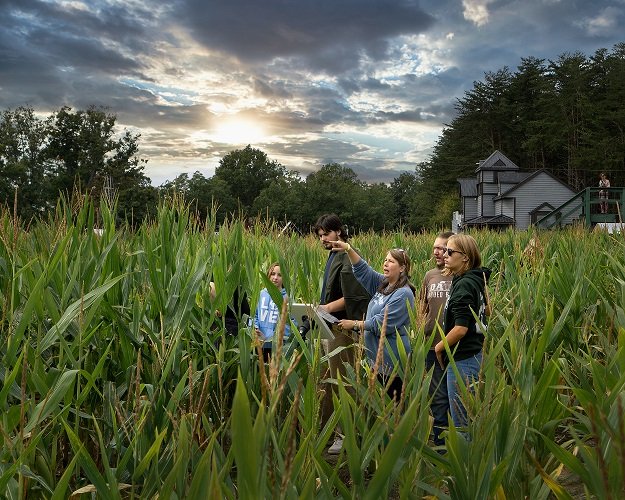A corn maze is an outdoor puzzle carved into a cornfield, designed to offer a fun and challenging experience for visitors. These mazes vary in size and complexity, often featuring intricate pathways that require navigation through a series of twists and turns. They serve as popular agritourism attractions, blending entertainment with the natural setting of a farm.
Corn mazes are typically created by planting corn later in the season so the stalks remain sturdy, then cutting paths into the field based on a planned design. Many farms update their maze layout annually, adding trivia or themed challenges to enhance the visitor experience. This mix of physical navigation and interactive elements makes corn mazes a unique seasonal activity for families and groups.
Beyond being a recreational activity, corn mazes connect people to rural agriculture and local food producers. Visitors often find additional farm-fresh produce and handmade goods available nearby, enriching their outing with local flavors and crafts alongside the maze adventure.
What Is a Corn Maze?
A corn maze is a large outdoor labyrinth created by cutting paths through a cornfield. These mazes vary in complexity, size, and pattern, making them unique agricultural attractions. Their origin, design process, and different types reveal important aspects about their role in recreation and farming.
History and Origins
Corn mazes first appeared in the United States in the early 1990s. Don Frantz and Adrian Fisher created the first modern corn maze in 1993 on a Pennsylvania farm to attract visitors and market the farm’s produce. The idea quickly gained popularity during the fall season across North America.
Before corn mazes, hedge mazes were common in Europe, but adapting the concept to maize fields was a new approach. Corn mazes have since become a popular agritourism activity, combining farming and entertainment. They represent an evolution from traditional mazes into a farming-based recreational experience.
How Corn Mazes Are Designed
Designing a corn maze requires careful planning and agricultural knowledge. Farmers plant sturdier varieties of field corn, often two to three weeks later than typical food corn, to ensure strong stalk integrity during the busy visiting season.
The maze layout is created using computer software that maps out intricate patterns or themes. Paths are then cut or mowed through the cornfield after the planting has matured enough, allowing visitors to navigate the maze using visual cues from the stalks. Precision in cutting is critical for maze clarity and durability.
Types of Corn Mazes
Corn mazes come in various forms, each with different challenges and designs. Common types include:
- Traditional Mazes: Simple paths with multiple dead ends designed for casual exploration.
- Themed Mazes: Complex patterns often based on seasonal or cultural motifs.
- Puzzle Mazes: Incorporate challenges such as checkpoints or clues within the maze.
Farmers adapt maze types depending on their location, audience, and goals. Some designs aim to educate on geography or history, while others focus purely on entertainment.
Planning a Visit to a Corn Maze
Visitors should prepare for a hands-on outdoor experience that combines adventure, entertainment, and safety. Choosing the right time to visit, understanding how to navigate the maze, and participating in seasonal events can enhance the overall experience. Awareness of common safety concerns also ensures a secure outing.
Tips for Navigating Corn Mazes
Effective navigation starts with patience and observation. Visitors should look for landmarks like tall stalks, signs, or color-coded markers to keep track of their route. It helps to divide the group into pairs and communicate progress regularly.
Bringing a map, if available, is useful. If maps aren’t provided, marking your path with small objects or remembering distinctive spots can prevent walking in circles. Avoid rushing; moving deliberately lowers the chance of getting lost.
Phones should be charged and carried for communication and GPS use, but reliance on technology alone can be risky in areas with poor signal. Sticking to the paths and following any maze instructions improves safety.
Popular Corn Maze Attractions
Corn mazes often operate alongside other seasonal activities like pumpkin patches, hayrides, and petting zoos. Many farms offer additional games such as corn cannons or mini-golf.
Season passes are available at places like Happy Hollow Corn Maze, granting access to multiple attractions. Family-friendly zones for toddlers and educational tours about agriculture and local history are also common.
Some mazes feature unique themes yearly, adding variety to the challenge. These themes can include holiday motifs or local wildlife, enhancing the visit with additional points of interest.
Seasonal Activities and Events
Corn mazes typically open in September through October when the weather cools. Weekends often feature special events such as harvest festivals, live music, and food vendors.
Farmers may host race events through the maze or night-time “haunted” versions during Halloween. These events provide a different dimension to the maze experience, often requiring tickets or reservations.
Families can usually find activities tailored to different age groups, including crafts or educational sessions about crops and farming practices. Checking the event calendar on the farm’s website before visiting helps plan a visit around these offerings.
Safety Precautions
Visitors should dress appropriately for outdoor terrain, wearing comfortable shoes and weather-suitable clothing. Corn maze paths can be uneven or muddy depending on the season.
It is important to stay on marked paths to avoid damaging crops and for personal safety. Children should be supervised closely, and groups should stay together.
Farms advise carrying water and flashlights if planning to stay until dusk or later. Emergency contact numbers and first-aid stations should be noted upon arrival. Avoid visiting alone or without informing others of the plans, especially in large or complex mazes.
